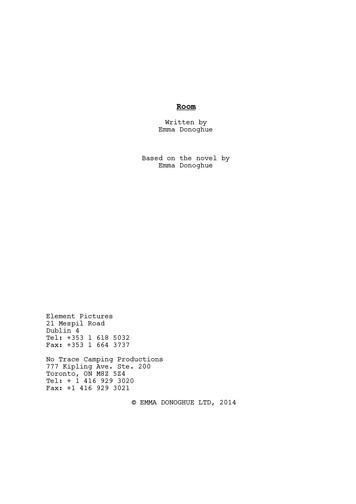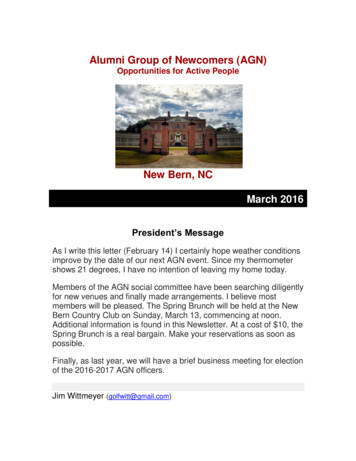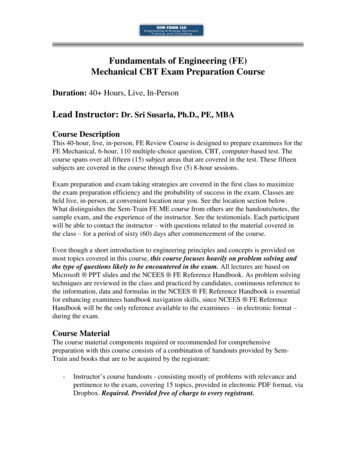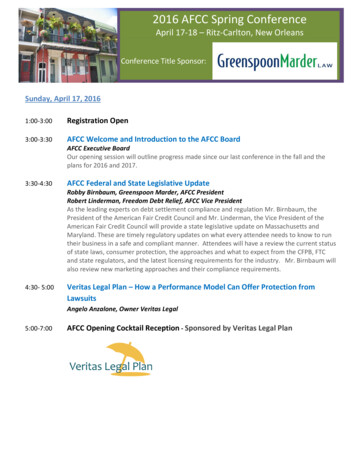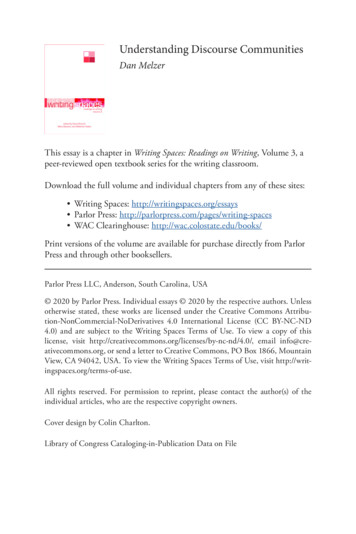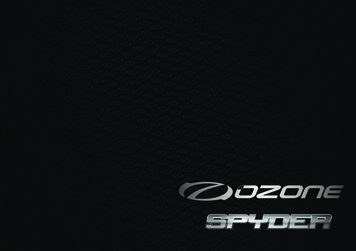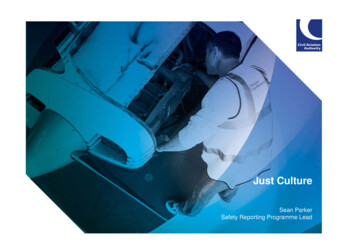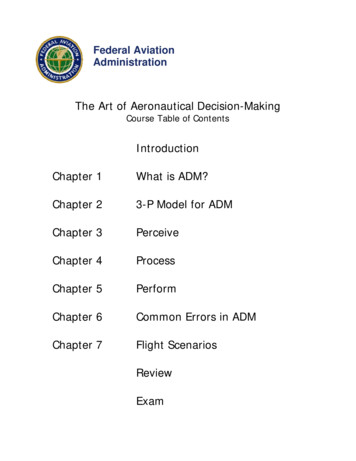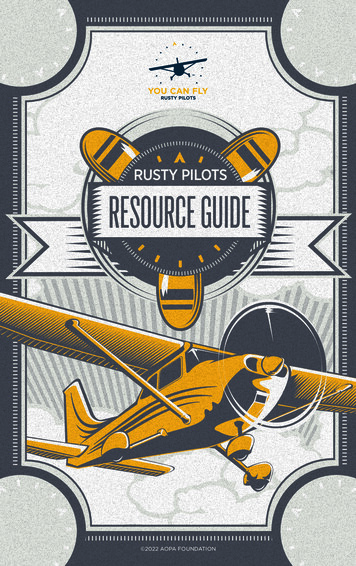
Transcription
RUSTY PILOTSRESOURCE GUIDE 2022 AOPA FOUNDATION
CONTENTSPre-flight Preparation (Documents, weather, NOTAMs) . . . . . . . . . 4Airport Operations (Markings & procedures) . . . . . . . . . . . . . . . 20Radio Communications . . . . . . . . . . . . . . . . . . . . . . . . . . . 29Airspace & Charts . . . . . . . . . . . . . . . . . . . . . . . . . . . . . . 36Resources . . . . . . . . . . . . . . . . . . . . . . . . . . . . . . . . . . . 42
INTRODUCTIONWELCOME TO RUSTY PILOTS!Your First Step Back into the Left SeatnWe are very excited to see that you are returning to the aviationcommunity. It’s a huge step you’ve taken by joining us today andwe’re glad to have you back. Our Rusty Pilots motto is “Once aPilot, Always a Pilot”—so let’s get started and get you back inthe air!Don’t Forget that AOPA is Here for You!nCompleted your flight review? We want to know! Plus, we’llsend you a free Rusty Pilots patch. Just fill out the shortonline survey that you’ll receive by email or contact us atRustyPilots@aopa.org. Your responses help us to know howwe’re doing and earn continued support for the program.nFlying Clubs are a great way to experience GA and sharethe costs with other like-minded folks. We can help you find,or start a flying club in your area. Interested? Just emailFlyingClubNetwork@aopa.org or visit youcanfly.aopa.org/flying-clubsnMedical issues or other aviation questions? Be sure to contactour team of aviation medical specialists and CFIs in AOPA’s PilotInformation Center. Call 1-800-USA-AOPA.nIs your AOPA membership current? We’d love to have you inour family. Plus, you’ll be able to enjoy a wealth of aviationresources, award-winning magazines, and more! Give ourmembership team a call at 1-800-USA-AOPA.RUSTY PILOTS RESOURCE GUIDE 3
PRE-FLIGHT PREPARATIONREGULATORY REQUIREMENTSPilot DocumentsnPlastic Pilot Certificate (14 CFR 61.19(g)) –no more paper certificatenGovernment-issued photo ID (14 CFR 61.3)nFlight review (14 CFR 61.56) – every 24 calendar months90-day landing currency (14 CFR 61.57)Day 3 takeoffs and 3 landings Night 3 takeoffs and 3 landings to a full stop(1 hour after sunset until 1 hour before sunrise)nMedical Certificate (if required) Medical Certificate (14 CFR 61.23) – Third Class MedicalUnder 40 years old 60 months40 years or older 24 monthsnnBasicMed (14 CFR 68) (if required)Can I fly under BasicMed now? Yes, BasicMed became effective on May 1, 2017. Pilots cannow visit their personal physician and complete an onlinecourse to become qualified under BasicMed. Get startedhere: aopa.org/FitToFlyHow can I qualify for BasicMed? Hold a valid U.S. driver’s license and comply withany restrictions. Have held a valid FAA medical certificate, regular orspecial issuance, on or after July 15, 2006. If you’ve never held a medical certificate, you will needto get an FAA medical certificate, regular or specialissuance, from an AME one time only. If your regular or special issuance medical certificatelapsed before July 15, 2006, you will need to get amedical certificate from an AME one time only.4 RUSTY PILOTS RESOURCE GUIDE
PRE-FLIGHT PREPARATION If you have a medical history or diagnosis of certaincardiac, neurological, or mental health conditions, youwill need a one-time only special issuance for eachcondition. If your most recent medical certificate has beensuspended at any point in time or revoked, your mostrecent authorization for special issuance was withdrawn,or your most recent medical application was denied, youwill need to obtain a new medical certificate before youcan operate under BasicMed.What will I have to do to take advantage of BasicMed? At least every 48 months, visit a state licensed physicianwhere he or she will perform an examination to completethe FAA’s BasicMed comprehensive medical examinationchecklist (CMEC). The completed checklist is retainedwith your logbook or kept in an electronic format, andonly made available to the FAA upon request. Every 24 calendar months, take a free, online medicaleducation course. AOPA’s online medical education courseis available to all individuals, free of charge. When youcomplete the course, you will receive a certificate to beretained with your logbook or kept in an electronic format. What are the aircraft and operating restrictions underBasicMed? You must fly an aircraft with a maximum certificated takeoffweight up to 6,000 pounds that is authorized to carryno more than six occupants; fly with no more than fivepassengers; conduct flights within the United States (unlessauthorized by the country in which the flight is conducted);fly at an indicated airspeed of 250 knots or less; and fly at analtitude at or below 18,000 feet mean sea level. You will not be able to fly for compensation or hire, exceptin limited situations as permitted by FAR 61.113 such ascharitable flying, sharing costs of flights with passengers,and flying in connection with a business only if the flight isincidental to that business and does not carry any passengersor property for compensation or hire.RUSTY PILOTS RESOURCE GUIDE 5
PRE-FLIGHT PREPARATIONDoes BasicMed apply to flight instructors? Yes. The FAA has stated that “flight instructors meeting therequirements of this rule may act as PIC while giving flighttraining without holding a medical certificate, regardless ofwhether the person receiving flight training holds a medicalcertificate.”What if I want to operate outside the BasicMed limitations? If you are BasicMed qualified but also hold a current FAAmedical certificate, you may elect to exercise the privilegesof your medical certificate as appropriate. However, if apilot exercises BasicMed privileges while acting as pilot incommand during any portion of a flight, then the entire flightmust be conducted under BasicMed limitations.What if I still have questions? Check AOPA’s online Fit to Fly Resources for pilots andphysicians at aopa.org/FitToFly. Call the AOPA Pilot Information Center BasicMednumber 888-462-3976. You can also enroll in AOPA’s Pilot Protection Servicesto access our Legal Services Plan attorneys and medicalcertification specialists who can evaluate the facts of yourindividual circumstances to help you determine your eligibilityto fly under BasicMed. Enroll today at aopa.org/pps.Physical Condition: I’M SAFE ChecklistnnIllness (14 CFR 61.53)—May not operate an aircraft as PICor required crewmember if unable to meet requirements ofmedical certificate or Medication (14 CFR 61.53)—See the AOPA Medication cations-DatabasennnnStressAlcohol (14 CFR 91.17)—At least 8 hours from bottle to throttleFatigueEmotion6 RUSTY PILOTS RESOURCE GUIDE
PRE-FLIGHT PREPARATIONAERONAUTICAL DECISION MAKINGASI “Do the Right Thing” Course and Safety AdvisorMost accidents that stem from bad decisions include at least one of thefollowing factors:Utility: Attempting to squeeze too much utility out of the airplane.Ability: Pushing the limits of pilot skill or experience.Fun: Trying to have too much fun in the airplane. This shows up inaccident reports as buzzing, low-level flight, improper aerobatics, etc.Good decision making is about avoiding the circumstances that lead toreally tough choices.Go/No-Go? It may seem obvious, but some of the best aeronauticaldecisions are made on the ground. A prudent preflight choice caneliminate the need to make a much more difficult in-flight decision.Beyond Go/No-Go: So, you’ve decided to go. Once in the air,you should enter a continuous decision-making cycle. Take theknowledge and information you already have, combine it with thenew information you’re gathering as you fly, and actively decidehow to proceed.nnnAnticipate: What could go wrong? Effective decision making begins withanticipation—thinking about what could go wrong before it actually does.Recognize: Has something gone wrong? Avoid problems in flight by payingattention! The sooner you recognize a problem (or potential problem) andstart thinking about how to handle it, the better.Act: Evaluate your options and choose one. Here’s where many pilots fail.They recognize the problem, but don’t do anything to confront it. Why?It’s inconvenient. Be prepared to act without delay, should the situationwarrant it. Pilots sometimes tend to enter a state of denial when faced witha problem. At the risk of oversimplifying, the basic options available when aproblem arises are as follows:1. Continue the flight as planned, paying very close attention towhatever is causing the problem;2. Continue the flight, deviating from the plan as necessary; or3. Get the airplane on the ground as soon as practical.nEvaluate: After implementing a solution, evaluate the decision to see ifyou’re getting the desired results. If not, repeat the process.RUSTY PILOTS RESOURCE GUIDE 7
PRE-FLIGHT PREPARATIONASI VFR PILOT PERSONAL MINIMUMS CONTRACTPersonal minimums and decision-making criteria are best defined on theground, free of external pressure and the workload of flying the aircraft.Writing them down makes it much easier to resist the temptation to“mentally negotiate” yourself into a tight spot, allowing your decisionmaking to be clouded in the heat of the moment by emotion and hope.This document defines the contract you make with yourself, yourpassengers, and your family.Remember to update your personal minimums regularly to reflect yourcurrent proficiency in the aircraft you’ll be flying.Instructions1n Review all sections and determine your personal minimumsspecific to the type of aircraft you fly. If you’re a new or rustypilot, consider asking a CFI for help.2n Fill in the information for each item.3n Keep this contract with your flight bag for quick reference.4n For a more detailed assessment of the potential risks beforeyour next flight, download and use the FAA’s Flight RiskAssessment tool at bit.ly/faaflightrisk.PILOTMIN. HOURS (LAST 30/90 DAYS)MIN. HOURS IN TYPE (LAST 30/90 DAYS)MIN. LANDINGS (LAST 30/90 DAYS)NIGHT HOURS (LAST 30/90 DAYS)////VFR INTO IMC TRAINING COMPLETED WITHIN PAST 12 MONTHSMIN. RECURRENT TRAINING COMPLETED(circle one) PAST 6 / 12 / 24 MONTHSASI recommends recurrent training every 12 months with a CFI who’s familiarwith the aircraft make, model, and equipment.8 RUSTY PILOTS RESOURCE GUIDE
PRE-FLIGHT PREPARATIONAT A MINIMUM, MY OVERALL WELLNESS SHOULD BEADEQUATEqOKWELLVERY WELLqqqASI recommends considering sleep, medications, alcohol, stress, and other factorsthat could affect the safety of flight.WEATHERMAX. WIND VELOCITY AND GUSTMAX. CROSSWINDMIN. CEILINGDAY NIGHTMIN. VISIBILITYDAY NIGHTAIRPORTRUNWAY MIN. LENGTHRUNWAY MIN. WIDTHAircraft performance degrades when density altitude is above 1,000 feet. Asa result, ASI recommends adding 50 percent to the POH takeoff or landingdistance over a 50-foot obstacle.AIRCRAFTMIN. FUEL RESERVES (hours : minutes)DAY:NIGHT:ASI recommends landing with at least one hour of fuel remaining.NIGHT FLIGHT IN A SINGLE-ENGINE AIRCRAFT Y / NIF YES, LIST LIMITATIONS (e.g., no mountainous terrain, no over-waterflights, will reach cruise altitude before sunset).RUSTY PILOTS RESOURCE GUIDE 9
PRE-FLIGHT PREPARATIONI WILLnOnly fly when I am proficient with the aircraft limitations,performance, normal and emergency procedures, systems, andavionics.nUse precautions when transitioning to different aircraft/avionics/systems.nConsider the risks of flying over mountainous terrain.nFly with a current GPS database, charts (or EFB), and a backup(as required).nConsider increasing my personal minimums if friends and familyare on board.nAlways get a recorded FAA weather briefing and file/activate aflight plan for flights away from home base.nRequest flight following if services are available.nFly with a qualified pilot or CFI (or postpone the flight) if mypersonal minimums are not met.Pilot signatureCFI/witnessLast updated/ /The IFR PILOT PERSONAL MINIMUMS CONTRACT is availableonline at airsafetyinstitute.org/ifrcontract. AOPA Air Safety Institute10 RUSTY PILOTS RESOURCE GUIDE
PRE-FLIGHT PREPARATIONAIRCRAFT AIRWORTHINESS REQUIREMENTSAircraft Documents (ARROW PC)Airworthiness CertificateRegistration Certificate (re-registration every 3 years)Radio Station License (*only for international flights)Operating Handbook (N# or SN#)Weight and BalancePlacardsCompass CardRequired Maintenance & Inspections (AVIATE) Note: IFRinspections marked with*Airworthiness Directives (one time vs. recurring)VOR Check (every 30 days)*Inspections (Annual & 100 hour [if used for instruction or hire])Altimeter/Pitot Static system (every 24 calendar months)*Transponder (every 24 calendar months)ELT inspection (12 calendar months; plus half useful life of battery or 1hour of cumulative use)Preventive MaintenanceAccording to 14 CFR Part 43, Maintenance, Preventive Maintenance,Rebuilding, and Alteration, the holder of a pilot certificate issuedunder 14 CFR Part 61 may perform specified preventive maintenanceon any aircraft owned or operated by that pilot, as long as theaircraft is not used under 14 CFR Part 121, 127, 129, or 135. See FAApamphlet (FAA-P-8740-15) for more information.Here are several important points to understand before you attempt toperform your own preventive maintenance:RUSTY PILOTS RESOURCE GUIDE 11
PRE-FLIGHT PREPARATIONnYou need to understand that authorized preventive maintenancecannot involve complex assembly operations.nYou should carefully review 14 CFR Part 43, Appendix A,Subpart C (Preventive Maintenance), which provides a list of theauthorized preventive maintenance work that an owner pilotmay perform.nYou should conduct a self-analysis as to whether you have theability to perform the work satisfactorily and safely.nIf you do any of the preventive maintenance authorized in 14CFR Part 43, you will need to make an entry in the appropriatelogbook or record system in order to document the work done.The entry must include the following information:A description of the work performed, or references to datathat are acceptable to the Administrator.The date of completion.The signature, certificate number, and kind of certificateheld by the person performing the work. Note that thesignature constitutes approval for return to service only forwork performed.14 CFR 91.7 (PIC Responsibility for Airworthiness)As a certificated pilot you can perform preventive maintenance, subjectto some limitations. CFR 43.3(g) says so. Before doing so, however, itwould be wise to review the bullet points below:nNo person may operate a civil aircraft unless it is in an airworthycondition.nThe pilot in command of a civil aircraft is responsible fordetermining whether that aircraft is in condition for safeflight. The pilot in command shall discontinue the flight whenunairworthy mechanical, electrical, or structural conditionsoccur.12 RUSTY PILOTS RESOURCE GUIDE
PRE-FLIGHT PREPARATIONADS-B OUT (AUTOMATIC DEPENDENTSURVEILLANCE - BROADCAST)What is Automatic Dependent Surveillance – Broadcast?n Aprimary technology supporting the FAA’s Next Generation AirTransportation System (NextGen).n Shiftsn Requiredaircraft separation and air traffic control from groundbased radar to satellite-derived positions.in the continental U.S. since January 2, 2020 underFAR 91.225.How Does Automatic Dependent Surveillance –Broacast Work?n Broadcastsan aircraft’s WAAS-enhanced GPS position to theground where it is displayed to air traffic controllers.n It’salso transmitted to aircraft with ADS-B receivers eitherdirectly or relayed by ground stations.RUSTY PILOTS RESOURCE GUIDE 13
PRE-FLIGHT PREPARATIONWhere is Automatic Dependent Surveillance –Broadcast required?nClass A, B and C airspace.n ClassAGL.E at or above 10,000’ MSL excluding airspace below 2500’nWithin 30 nm of a Class B primary airport (the Mode C veil)n Aboven Classn Exceptthe ceiling and within the lateral boundaries of Class B orC airspace up to 10,000’ msl.E airspace over the Gulf of Mexico, at and above 3,000feet msl, within 12 nm of the U.S. coast.for the airspace over the Gulf this is the same airspacewhere a transponder is required today.14 RUSTY PILOTS RESOURCE GUIDE
PRE-FLIGHT PREPARATIONWhat if my airplane doesn’t have ADS-B?n Ifyou’re not equipped with ADS-B Out, you’re not necessarilyshut out of the airspace—but you’ll have some extra work to What are the benefits of flying with ADS-B?n Theability to fly in ADS-B airspace at any time if the need arises.n Enhancedn Maintainn Moren Moresafety and additional situational awareness from traffic and free weather information (if you also opt for ADS-B In orhave a portable ADS-B receiver).airframe value. (Aircraft that are not ADS-B equippedare likely to fall in value.)efficient search and rescue. ADS-B’s GPS-based surveillance provides more accurate information about an aircraft’s lastreported position. This is because ADS-B Out avionics transmitdata approximately once every second, compared to a groundbased radar’s sweep rate of 3-15 seconds.efficient spacing and optimal IFR routing in nonradar environments, including the Gulf of Mexico, mountainous regions ofColorado, and lower altitudes in some parts of Alaska.Where can I find more information?n AOPAn Seehas lots of information and resources available on USTY PILOTS RESOURCE GUIDE 15
PRE-FLIGHT PREPARATIONWEATHER: METAR & TAF DECODERKey to TAF and METAR (Front)TAF KPIT 091730Z 0918/1024 15005KT 5SM HZ FEW020 WS010/31022KTFM091930 30015G25KT 3SM SHRA OVC015TEMPO 0920/0922 1/2SM TSRA OVC008CBFM100100 27008KT 5SM SHRA BKN020 OVC040PROB30 1004/1007 1SM -RA BRFM101015 18005KT 6SM -SHRA OVC020BECMG 1013/1015 P6SM NSW SKCNOTE: Users are cautioned to confirm DATE and TIME of the TAF. For example, FM100000 is 0000Zon the 10th. Do not confuse with 1000Z!METAR KPIT 091955Z COR 22015G25KT 3/4SM R28L/2600FT TSRA OVC010CB 18/16 A2992 RMKSLP045 T01820159ForecastExplanationTAFMessage type: TAF-routine or TAF AMD-amended forecast, METAR-hourly, SPECIspecial or TESTM-non-commissioned ASOS reportICAO location indicatorIssuance time: ALL times in UTC “Z”, 2-digit date, 4-digit timeValid period, either 24 hours or 30 hours. The first 2 digits of EACH 4-digit numberindicate the date of the valid period, the final 2 digits indicate the time (valid from 18Zon the 9th to 24Z on the 10th).In U.S. METAR: CORrected of; or AUTOmated ob for automated report with no humanintervention; omitted when observer logs on.Wind: 3 digit true-north direction, nearest 10 degrees (or VaRiaBle); next 2-3 digitsfor speed and unit, KT (KMH or MPS); as needed, Gust and maximum speed;00000KT for calm; for METAR, if direction varies 60 degrees or more, Variabilityappended, e.g., 180V260Prevailing visibility; in U.S., Statute Miles & fractions; above 6 miles in TAF Plus6SM.(Or, 4-digit minimum visibility in meters and as required, lowest value with direction)METARRunway Visual Range: R; 2-digit runway designator Left, Center, or Right as needed;“/”, Minus or Plus in U.S., 4-digit value, FeeT in U.S., (usually meters elsewhere);4-digit value Variability 4-digit value (and tendency Down, Up or No change)Significant present, forecast and recent weather: see table (on back)Cloud amount, height and type: SKy Clear 0/8, FEW 0/8-2/8, SCaTtered 3/8- 4/8,BroKeN 5/8-7/8, OVerCast 8/8; 3-digit height in hundreds of ft; Towering CUmulusor CumulonimBus in METAR; in TAF, only CB. Vertical Visibility for obscured skyand height “VV004”. More than 1 layer may be reported or forecast. In automatedMETAR reports only, CLeaR for “clear below 12,000 feet”Temperature: degrees Celsius; first 2 digits, temperature “/” last 2 digits, dew- pointtemperature; Minus for below zero, e.g., M06Altimeter setting: indicator and 4 digits; in U.S., A-inches and hundredths; (QhectoPascals, e.g., Q1013)In U.S. TAF, non-convective low-level ( 2,000 ft) Wind Shear; 3-digit height(hundreds of ft); “/”; 3-digit wind direction and 2-3 digit wind speed above theindicated height, and unit, 0WS010/31022KT16 RUSTY PILOTS RESOURCE GUIDEReportKPIT091955ZCOR22015G25KT3/4SMTSRAOVC 010CB18/16A2992
PRE-FLIGHT PREPARATIONKey to TAF and METAR 7BECMG1013/1015ExplanationIn METAR, ReMarK indicator & remarks. For example: Sea-Level Pressure inhectoPascals & tenths, as shown: 1004.5 hPa; Temp/dew-point in tenths C, asshown: temp. 18.2 C, dew-point 15.9 CFroM: changes are expected at: 2-digit date, 2-digit hour, and 2-digit minutebeginning time: indicates significant change. Each FM starts on a new line, indented5 spacesTEMPOrary: changes expected for 1 hour and in total, half of the period betweenthe 2-digit date and 2-digit hour beginning, and 2-digit date and 2-digit hour endingtimePROBability and 2-digit percent (30 or 40): probable condition in the period betweenthe 2-digit date & 2-digit hour beginning time, and the 2- digit date and 2-digit hourending timeBECoMinG: change expected in the period between the 2-digit date and 2-digit hourbeginning time, and the 2-digit date and 2-digit hour ending timeReportRMK SLP045T01820159Table of Significant Present, Forecast and Recent Weather - Grouped in categoriesand used in the order listed below; or as needed in TAF, No Significant Weather.QualifiersIntensity or Proximity“-” lightNo sign Moderate“ ” Heavy“VC” Vicinity, but not at aerodrome. In the US METAR, 5 to 10 SM from the point of observation. In theUS TAF, 5 to 10 SM from the center of the runway complex. Elsewhere, within 8000m.DescriptorBC – PatchesBL – BlowingDR – DriftingFZ – FreezingMI – ShallowPR – PartialSH – ShowersTS – ThunderstormDZ – DrizzleGR – HailGS – Small Hail/Snow PelletsIC – Ice CrystalsPL – Ice PelletsRA – RainSN – SnowUP – Unknown Precipitation in automated observationsWeather PhenomenaPrecipitationSG – Snow GrainsObscurationBR – Mist ( 5/8SM)DU – Widespread DustFG – Fog ( 5/8SM)FU – SmokeHZ – HazePY – SpraySA – SandVA – Volcanic AshOtherDS – Dust StormFC – Funnel Cloud FC – Tornado or WaterspoutPO – Well developed dust or sand whirlsSQ – SquallSS – SandstormExplanations in parentheses “()” indicate different worldwide practices.Ceiling is not specified; defined as the lowest broken or overcast layer, or the vertical visibility.NWS TAFs exclude BECMG groups and temperature forecasts, NWS TAFS do not use PROB in the first 9 hours of aTAF; NWS METARs exclude trend forecasts. US Military TAFs include Turbulence and Icing groups.RUSTY PILOTS RESOURCE GUIDE 17
PRE-FLIGHT PREPARATIONWEATHER INFORMATION:This website will record your transaction.1800wxbrief.comIf using an EFB, the company may record your briefing to FAAsatisfaction. Check accordingly.This website provides information only.aviationweather.govWEATHER BRIEFING OVER THE PHONE:1-800-WX Brief (1-800-992-7433)Information you will need to provide once they answer(just say it all – do not pause in between items for them to respond):n Certificaten Typeof flight: VFR or IFRn Aircraftn Typeyou hold: Private pilot, Commercial pilot, etc.number: Nof aircraft: Make / Modeln Departuren Routepointof flightn Arrivalpointn Altituden Estimatedtime of departure (specify local or Zulu)n Estimatedtime en routen Typeof briefing requested: Standard Briefing, Outlook Briefing,Abbreviated BriefingExample: Good morning. I am a private pilot and will be making a VFRflight in N14GA which is a Cessna Skyhawk. I’ll be departing out of SRQdirect to ISM at 3500’. Time of departure will be 2:00pm local andtime en route will be approximately 45 minutes. I would like a StandardBriefing.18 RUSTY PILOTS RESOURCE GUIDE
PRE-FLIGHT PREPARATIONJust remember, you are talking to a person and not a computer. If youforget something, they will ask about it. At any time, you can ask foradditional information as well.The briefer will respond with the following information:n Adversen VFRconditionsnot recommended (if applicable)n Synopsisn Currentn Enconditionsroute forecastn Destinationn Forecastn Noticesn Otherforecastwinds and temperatures aloftto Airmen (NOTAM)informationSearch online for “FAA Weather Briefing Form” and you’ll find an easyto use form. For more information, refer to Advisory Circular 91-92,Pilot’s Guide to a Preflight Briefing.SUMMARY OF TYPES OF NOTAMSFDC NOTAMSFlight Data Center NOTAMS are NOTAMs that are regulatory innature, such as changes to an instrument approach procedureor airway. Temporary Flight Restrictions (TFRs) are also issuedas FDC NOTAMs.NOTAM (D)A NOTAM (D) is a NOTAM given (in addition to localdissemination) distant dissemination beyond the area ofresponsibility of the Flight Service Station. This type of NOTAMnow includes (U) NOTAMs and (O) NOTAMs. (U) NOTAMs areunverified NOTAMs which are those that are received from asource other than airport management and have not yet beenconfirmed by management personnel. This is allowed only atthose airports where airport management has authorized itby Letter of Agreement. (O) NOTAMs are other aeronauticalinformation which does not meet NOTAM criteria but may bebeneficial to aircraft operations.RUSTY PILOTS RESOURCE GUIDE 19
AIRPORT OPERATIONSAIRPORT SIGNAGEAdapted from ASI Runway Safety Flash Cards available online index.phpTaxiway Direction SignIn many cases, taxiway directionsigns are placed next to taxiwaylocation signs. The black signtells you which taxiway you’re on,while the yellow sign identifies anupcoming taxiway.Ref. AIM Para. 2-3-9/10Destination SignIndicates the direction of a taxiroute to a runway(s) or otherlocation.Ref. AIM Para. 2-3-11Taxiway Location SignIndicates the taxiway on whichthe aircraft is located. At largerairports, some taxiways havealphanumeric identifiers (e.g., A3,A4) and some have double-samedesignators (e.g., AA, BB).Ref. AIM Para. 2-3-9-a-1RUSTY PILOTS RESOURCE GUIDE 20
AIRPORT OPERATIONSRunway Holding Position Sign(Collocated with Taxiway Location Sign)Located next to the yellowholding position surface markingon taxiways for taxiway/runwayintersections. This sign is oftencollocated with a taxiway location.In this example, the thresholdfor Runway 21 is to the left andthe threshold for Runway 3 is tothe right. Aircraft may not movebeyond this sign/marking unlessinstructed by ATC at toweredairports, or by ensuring adequateseparation of aircraft at nontowered airports.Ref. AIM Para. 2-3-8-b-2Runway Approach Area Holding Position SignLocated next to the yellowholding position surface markings.Taxiing past this sign may interferewith arriving or departing aircraft.Hold short of this location wheninstructed by ATC.Ref. AIM Para. 2-3-8-b-2; 4-3-18-a-8ILS Critical Area Holding Position SignLocated next to the yellowsurface-painted ILS critical areamarking. Aircraft taxiing beyondthis point may interfere withthe ILS signal. Hold short of thislocation when instructed by ATC.Ref. AIM Para. 2-3-8-b-3; 4-3-18-a-821 RUSTY PILOTS RESOURCE GUIDE
AIRPORT OPERATIONSNo Entry SignProhibits an aircraft from enteringan area, such as a one-waytaxiway or the intersection of aroad intended for vehicles.Ref. AIM Para. 2-3-8-b-4Runway Location SignIdentifies the runway on which theaircraft is located.Ref. AIM Para. 2-3-9-a-2Runway Distance Remaining SignIndicates the distance of runwayremaining in thousands of feet. Inthis example, 3,000 feet remainon the landing runway. These areusually seen at larger airports.Ref. AIM Para. 2-3-13RUSTY PILOTS RESOURCE GUIDE 22
AIRPORT OPERATIONSRunway MarkingsALL WHITE MARKINGSRunway markings vary with thesize and type of runway, but theyare always white.Ref. AIM Para. 2-3-3Displaced ThresholdA displaced threshold designateswhere the runway’s landing areastarts. White arrows along thecenterline of the runway indicatethe portion between the beginningof the runway and the displacedthreshold. This portion is availablefor takeoffs in both directions andlandings from the opposite direction.*Unless declared distances are in effect. Consultthe FAA U.S. Chart Supplements (formerly,Airport/Facility Directory (A/FD)) to confirmavailable landing distances in each direction.Ref. AIM Para. 2-3-3-h-2Chevron MarkingsIndicate areas of pavementaligned with the runway thatare unusable for taxi, takeoff, orlanding. Chevrons cover blastpads or stopways, which areconstructed to protect areas fromerosion caused by jet blast and toprovide extra stopping distancefor aircraft (stopways).Ref. AIM Para. 2-3-3-i-123 RUSTY PILOTS RESOURCE GUIDE
AIRPORT OPERATIONSNon-Movement Area Boundary MarkingsThese markings can be seen attowered airports where hangar orapron areas are located adjacentto a taxiway. The dashed sideindicates the movement area,which is under ATC control, andthe solid line indicates thenon-movement area (e.g., FBOramps and hangar areas), which isnot under ATC control.Ref. AIM Para. 2-3-6-cRunway Holding Position Markings on Taxiways(Runway Perspective)The dashed lines of the holdingposition marking are always onthe runway side. Aircraft exitingthe runway are not considered“clear” until they’re across theentire marking. From the runwayperspective, the pavementmarkings are mirrored by a runwayboundary sign with the samesymbol as the pavement markings.Ref. AIM Para. 2-3-5-a-1Taxiway MarkingsSpecific marking styles varysomewhat, but taxiway markingsare always yellow.Ref. AIM Para. 2-3-4RUSTY PILOTS RESOURCE GUIDE 24
AIRPORT OPERATIONSEnhanced Taxiway Centerline MarkingsThese markings indicate that theaircraft is approaching a runway.Prior to a runway holding positionmarking, the taxiway centerlinewill be “enhanced” to include a setof yellow dashed lines. Installed atmore than 500 airports throughoutthe U.S., these dashed yellowmarkings extend 150 fe
4 RUSTY PILOTS RESOURCE GUIDE REGULATORY REQUIREMENTS Pilot Documents n Plastic Pilot Certificate (14 CFR 6119(g)) – . no more paper certificate n Government-issued photo ID (14 CFR 61 .3) n Flight review (14 CFR 61 .56) – every 24 calendar months n 90-day landing currency (14 CFR 61 .57) Day 3 takeo
